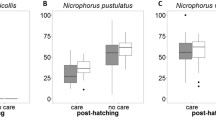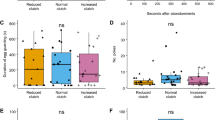Abstract
Parental care provides considerable benefits to offspring and is widespread among animals, yet it is relatively uncommon among squamate reptiles (e.g., lizards and snakes). However, all pythonine snakes show extended maternal egg brooding with some species being facultatively endothermic. While facultative endothermy provides thermal benefits, the presence of brooding in non-endothermic species suggests other potential benefits of brooding. In this study we experimentally tested the functional significance of maternal brooding relative to water balance in the children’s python, Antaresia childreni, a small species that does not exhibit facultative endothermy. Clutch evaporative water loss (EWL) was positively correlated with clutch mass and was much lower than expected values based on individual eggs. The conglomerate clutch behaved as a single unit with a decreasing surface area to volume ratio as clutch size increased. Maternal brooding had a dramatic impact on evaporation from eggs, reducing and possibly eliminating clutch EWL. In a separate experiment, we found that viability of unattended eggs is highly affected by humidity level, even in the narrow range from 75 to 100% relative humidity at 30.5°C (20–33 mg m−3 absolute humidity). However, the presence of the brooding female ameliorated this sensitivity, as viability of brooded clutches at 75% relative humidity was higher than that of non-brooded eggs at either the same absolute humidity or at near-saturated conditions. Overall, these results demonstrate that brooding behavior strongly promotes egg water balance (and thus egg viability) in children’s pythons.




Similar content being viewed by others
References
Ackerman RA (1991) Physical factors affecting the water exchange of buried reptile eggs. In: Deeming DC, Ferguson MWJ (eds) Egg incubation: its effects on embryonic development in birds and reptiles. Cambridge University Press, Cambridge, pp 193–211
Ackerman RA, Seagrave RC, Dmi’el R, Ar A (1985) Water and heat exchange between parchment shelled reptile eggs and their surroundings. Copeia 1985:703–711
Aubret F, Bonnet X, Shine R, Maumelat S (2003) Clutch size manipulation, hatching success and offspring phenotype in the ball python (Python regius). Biol J Linnaean Soc 78:263–272
Aubret F, Bonnet X, Shine R, Maumelat S (2005) Why do female ball pythons (Python regius) coil so tightly around their eggs? Evol Ecol Res 7:743–758
Belinsky A, Ackerman RA, Dmi’el R, Ar A (2004) Water in reptilian eggs and hatchlings. In: Deeming DC (ed) Reptilian incubation: environment, evolution and behaviour. Nottingham University Press, Nottingham, pp 125–141
Branch WR, Patterson RW (1975) Notes on the development of embryos of the African rock python, Python sebae (Serpentes: Boidae). J Herpetol 9:243–248
Brown GP, Shine R (2004) Maternal nest-site choice and offspring fitness in a tropical snake (Tropidonophis mairii, Colubridae). Ecology 85:1627–1634
Brown GP, Shine R (2005) Do changing moisture levels during incubation influence phenotypic traits of hatchling snakes (Tropidonophis mairii, Colubridae)? Physiol Biochem Zool 78:524–530
Burger J, Zappalorti RT (1988) Effects of incubation temperature on sex ratios in pine snakes: differential vulnerability of males and females. Am Nat 132:492–505
Butler JA, Hull TW, Franz R (1995) Neonate aggregations ad maternal attendance of young in the eastern diamondback rattlesnake, Crotalus adamanteus. Copeia 1995:196–198
Campbell GS, Norman JM (1998) An introduction to environmental biophysics, 2nd edn. Springer, Heidelberg
Clutton-Brock TH (1991) The evolution of parental care. Princeton University Press, Princeton
Deeming DC, Ferguson MWJ (1991) Physiological effects of incubation temperature on embryonic development in reptiles and birds. In: Deeming DC, Ferguson MWJ (eds) Egg incubation: its effects on embryonic development in birds and reptiles. Cambridge University Press, Cambridge, pp 147–171
Deeming DC, Thompson MB (1991) Reptilian egg shell gas exchange. In: Deeming DC, Ferguson MWJ (eds) Egg incubation: its effects on embryonic development in birds and reptiles. Cambridge University Press, Cambridge, pp 277–284
Dmi’el R (1998) Skin resistance to evaporative water loss in viperid snakes: habitat aridity versus taxonomic status. Comp Biochem Physiol A 121:1–5
Dmi’el R (2001) Skin resistance to evaporative water loss in reptiles: a physiological adaptive mechanism to environmental stress or a phyletically dictated trait? Isr J Zool 47:55–67
Du WG (2004) Water exchange of flexible-shelled eggs and its effect on hatchling traits in the Chinese skink, Eumeces chinensis. J Comp Physiol B 174:489–493
Ellis TM, Chappell MA (1987) Metabolism, temperature relations, maternal behavior, and reproductive energetics in the ball python (Python regius). J Comp Physiol B 157:393–402
Elphick MJ, Shine R (1998) Longterm effects of incubation temperatures on the morphology and locomotor performance of hatchling lizards (Bassiana duperreyi, Scincidae). Biol J Linn Soc 63:429–447
Flatau PJ, Walko RL, Cotton WR (1992) Polynomial fits to saturation vapor pressure. J Appl Meteorol 31:1507–1513
Grace J (1997) Captive breeding of the black-headed python Aspidites melanocephalus, the story continues. Monitor 9:8–9
Harlow P, Grigg G (1984) Shivering thermogenesis in a brooding python, Python spilotes spilotes. Copeia 1984:959–965
Hutchison VH, Dowling HG, Vinegar A (1966) Thermoregulation in a brooding female Indian python, Python molurus bivittatus. Science 151:694–696
Lasiewski RC, Acosta AL, Bernstein ML (1966) Evaporative water loss in birds. I. Characteristics of the open flow method of determination and their relation to estimates of thermoregulatory ability. Comp Biochem Physiol 19:445–457
Madsen T, Shine R (1999) Life history consequences of nest-site variation in tropical pythons (Liasis fuscus). Ecology 80:989–997
Marco A, Díaz-Paniagua C, Hidalgo-Vila J (2004) Influence of egg aggregation and soil moisture on incubation of flexible-shelled lacertid lizard eggs. Can J Zool 82:60–65
Oftedal OT (2002) The origin of lactation as a water source for parchment-shelled eggs. J Mammary Gland Biol Neoplasia 7:253–266
Packard GC (1991) The physiological and ecological importance of water to embryos of oviparous reptiles. In: Deeming DC, Ferguson MWJ (eds) Egg incubation: its effects on embryonic development in birds and reptiles. Cambridge University Press, Cambridge, pp 213–228
Packard GC, Packard MJ (1988) The physiological ecology of reptilian eggs and embryos. In: Gans C, Huey RB (eds) Biology of the reptilia, vol. 16, Ecology B. Alan R. Liss, New York, pp 523–605
Packard MJ, Packard GC, Boardman TJ (1980) Water-balance of eggs of zebra-tailed lizards (Callisaurus draconoides). Am Zool 20:743–743
Prange HD, Schmidt K (1969) Evaporative water loss in snakes. Comp Biochem Physiol 28:973
Price AH (1988) Observations on maternal behavior and neonatal aggregation in the western diamondback rattlesnake, Crotalus atrox (Crotalidae). Southwest Nat 33:370–373
Ross RA, Marzec G (1990) The reproductive husbandry of pythons and boas. Institute of Herpetological Research, Stanford
Shine R (1985) The evolution of viviparity in reptiles: an ecological analysis. In: Gans C, Billett F (eds) Biology of the reptilia, vol. 15, Development B. Wiley, New York, pp. 605–694
Shine R (1988) Parental care in reptiles. In: Gans C, Huey RB (eds) Biology of the reptilia, vol. 16, Ecology B. Alan R. Liss, New York, pp 275–329
Shine R (2004) Adaptive consequences of developmental plasticity. In: Deeming DC (eds) Reptilian incubation: environment, evolution and behaviour. Nottingham University Press, Nottingham, pp 187–210
Shine R, Elphick MJ, Harlow PS (1997a) The influence of natural incubation environments on the phenotypic traits of hatchling lizards. Ecology 78:2559–2568
Shine R, Madsen TRL, Elphick MJ, Harlow PS (1997b) The influence of nest temperature and maternal brooding on hatching phenotypes in water pythons. Ecology 78:1713–1721
Slip DJ, Shine R (1988) Reptilian endothermy: a field study of thermoregulation by brooding diamond pythons. J Zool 216:367–378
Somma LA, Fawcett JD (1989) Brooding behaviour of the prairie skink, Eumeces septentrionalis and its relationship to the hydric environment of the nest. Zool J Linn Society 95:245–256
Van Mierop LHS, Barnard SM (1976) Thermoregulation in a brooding female Python molurus bivittatus (Serpentes: Boidae). Copeia 1976:398–401
Van Mierop LHS, Barnard SM (1978) Further observations on thermoregulation in the brooding female Python molurus bivittatus (Serpentes: Boidae). Copeia 1978:615–621
Vinegar A (1973) Effects of temperature on growth and development of embryos of the Indian python, Python molurus (Reptilia: Serpentes: Boidae). Copeia 1973:171–173
Vinegar A, Hutchison VH, Dowling HG (1970) Metabolism, energetics, and thermoregulation during brooding of snakes of the genus Python (Reptilia, Biodie). Zoologica 55:19–49
Walsh T (1979) Husbandry and breeding of Chondropython viridis. Nat Assoc Sound Wildl Programs 1:10–22
Warner DA, Andrews RM (2002) Nest site selection in relation to temperature and moisture by the lizard Sceloporus undulatus. Herpetologica 58:399–407
Wilson K, Hardy CW (2002) Statistical analysis of sex ratios: a review. In: Hardy ICW (ed) Sex ratios: concepts and research methods. Cambridge University Press, Cambridge, pp 48–92
Wilson S, Swan G (2003) Reptiles of Australia. Princeton Field Guides, Princeton
Winne CT, Ryan TJ, Leiden Y, Dorcas ME (2001) Evaporative water loss in two natricine snakes, Nerodia fasciata and Seminatrix pygaea. J Herpetol 35:129–133
York DS, Burghardt GM (1988) Brooding in the Malayan pit viper, Calloselasma rhodostoma: temperature, relative humidity, and defensive behavior. Herpetol J 1:210–214
Acknowledgements
We thank Glenn Walsberg for use of his hygrometry equipment. Emily Taylor provided helpful comments on the manuscript, while Carolyn Christel, Benjamin Reeser, Sabrina Servanty, and Raphaël Jeanson assisted with snake care. Arizona State University (ASU) provided financial support. All experiments were first approved by the ASU Institutional Animal Care and Use Committee (protocol #01-617R).
Author information
Authors and Affiliations
Corresponding author
Additional information
Communicated by I. D. Hume.
Rights and permissions
About this article
Cite this article
Lourdais, O., Hoffman, T.C.M. & DeNardo, D.F. Maternal brooding in the children’s python (Antaresia childreni) promotes egg water balance. J Comp Physiol B 177, 569–577 (2007). https://doi.org/10.1007/s00360-007-0155-6
Received:
Revised:
Accepted:
Published:
Issue Date:
DOI: https://doi.org/10.1007/s00360-007-0155-6




